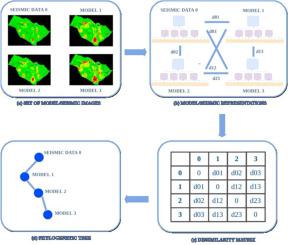当前位置:
X-MOL 学术
›
Comput. Geosci.
›
论文详情
Our official English website, www.x-mol.net, welcomes your
feedback! (Note: you will need to create a separate account there.)
A synthetic case study of measuring the misfit between 4D seismic data and numerical reservoir simulation models through the Momenta Tree
Computers & Geosciences ( IF 4.2 ) Pub Date : 2020-12-01 , DOI: 10.1016/j.cageo.2020.104617 Aurea Soriano-Vargas , Klaus Rollmann , Forlan Almeida , Alessandra Davolio , Bernd Hamann , Denis J. Schiozer , Anderson Rocha
Computers & Geosciences ( IF 4.2 ) Pub Date : 2020-12-01 , DOI: 10.1016/j.cageo.2020.104617 Aurea Soriano-Vargas , Klaus Rollmann , Forlan Almeida , Alessandra Davolio , Bernd Hamann , Denis J. Schiozer , Anderson Rocha

|
Abstract Data assimilation is an important and time-consuming process in petroleum reservoir numerical simulation. It produces a set of calibrated models used to forecast and optimize oil and gas production. The process focuses on reducing uncertainties related to reservoir properties, yielding numerical reservoir models that plausibly reproduce measured data from the field, such as well rates and pressure. Besides the traditional well-production data, 4D seismic data are increasingly being used to reduce the uncertainty of numerical reservoir models, by providing dynamic spatial data to be matched. Although 4D seismic data reveal essential information about the dynamic behavior of the reservoir, its integration in data assimilation procedures is challenging, especially in a quantitative way, because of their noisy and uncertain nature and their larger resolution when compared to the resolution of simulated data from numerical reservoir models. The development of metrics able to efficiently estimate the discrepancies between 4D seismic data and numerical reservoir model outputs is a current research interest for data assimilation, given the challenges of integrating these different types of data. We introduce the Momenta Tree. It uses orthogonal moments supporting a multi-level data representation, where features are organized in nodes related to different levels of region detail. It supports the comparison of simulated data from numerical reservoir models and observed 4D images of seismic data, images, using different resolutions and considering various domains. The similarity between data is calculated with the extended Jaccard distance and is represented by a phylogenetic tree; the simulated models are represented as circles in branches, and their similarity is captured by connections. We apply the Momenta Tree to a controlled case, introduced in this paper, to validate and compare the new metric with traditional metrics, and a more complex representative case based on real oil industry data. Our results show that the Momenta Tree metric retains the same sequential similarity in environments affected by noise. The highest-ranked models using the Momenta Tree relate to forecast behavior closer to the reference data than the highest-ranked models obtained with traditional methods. An additional advantage of the Momenta Tree is its ability to enable data comparison in various domains (P-impedance and Water Saturation) at different resolutions of seismic and simulation data.
中文翻译:

通过动量树测量 4D 地震数据与数值储层模拟模型之间的不匹配的综合案例研究
摘要 数据同化是油藏数值模拟中一个重要且耗时的过程。它生成一组校准模型,用于预测和优化石油和天然气生产。该过程侧重于减少与储层特性相关的不确定性,生成数值储层模型,可以合理地再现油田的测量数据,例如井速和压力。除了传统的井生产数据外,4D 地震数据越来越多地用于通过提供要匹配的动态空间数据来降低数值储层模型的不确定性。尽管 4D 地震数据揭示了有关储层动态行为的基本信息,但其在数据同化过程中的整合具有挑战性,尤其是在定量方面,因为与数值储层模型的模拟数据的分辨率相比,它们的噪声和不确定性以及分辨率更高。考虑到整合这些不同类型数据的挑战,开发能够有效估计 4D 地震数据和数值储层模型输出之间差异的指标是当前数据同化的研究兴趣。我们介绍动量树。它使用支持多级数据表示的正交矩,其中将特征组织在与不同区域细节级别相关的节点中。它支持对来自数值储层模型的模拟数据与地震数据的观测 4D 图像进行比较,图像使用不同的分辨率并考虑各种域。数据之间的相似度用扩展的Jaccard距离计算,用系统发育树表示;模拟模型用分支中的圆圈表示,它们的相似性由连接捕获。我们将 Momenta Tree 应用于本文中介绍的受控案例,以验证和比较新指标与传统指标以及基于实际石油行业数据的更复杂的代表性案例。我们的结果表明,Momenta Tree 度量在受噪声影响的环境中保留了相同的顺序相似性。与使用传统方法获得的最高排名模型相比,使用 Momenta 树的最高排名模型与更接近参考数据的预测行为相关。
更新日期:2020-12-01
中文翻译:

通过动量树测量 4D 地震数据与数值储层模拟模型之间的不匹配的综合案例研究
摘要 数据同化是油藏数值模拟中一个重要且耗时的过程。它生成一组校准模型,用于预测和优化石油和天然气生产。该过程侧重于减少与储层特性相关的不确定性,生成数值储层模型,可以合理地再现油田的测量数据,例如井速和压力。除了传统的井生产数据外,4D 地震数据越来越多地用于通过提供要匹配的动态空间数据来降低数值储层模型的不确定性。尽管 4D 地震数据揭示了有关储层动态行为的基本信息,但其在数据同化过程中的整合具有挑战性,尤其是在定量方面,因为与数值储层模型的模拟数据的分辨率相比,它们的噪声和不确定性以及分辨率更高。考虑到整合这些不同类型数据的挑战,开发能够有效估计 4D 地震数据和数值储层模型输出之间差异的指标是当前数据同化的研究兴趣。我们介绍动量树。它使用支持多级数据表示的正交矩,其中将特征组织在与不同区域细节级别相关的节点中。它支持对来自数值储层模型的模拟数据与地震数据的观测 4D 图像进行比较,图像使用不同的分辨率并考虑各种域。数据之间的相似度用扩展的Jaccard距离计算,用系统发育树表示;模拟模型用分支中的圆圈表示,它们的相似性由连接捕获。我们将 Momenta Tree 应用于本文中介绍的受控案例,以验证和比较新指标与传统指标以及基于实际石油行业数据的更复杂的代表性案例。我们的结果表明,Momenta Tree 度量在受噪声影响的环境中保留了相同的顺序相似性。与使用传统方法获得的最高排名模型相比,使用 Momenta 树的最高排名模型与更接近参考数据的预测行为相关。











































 京公网安备 11010802027423号
京公网安备 11010802027423号